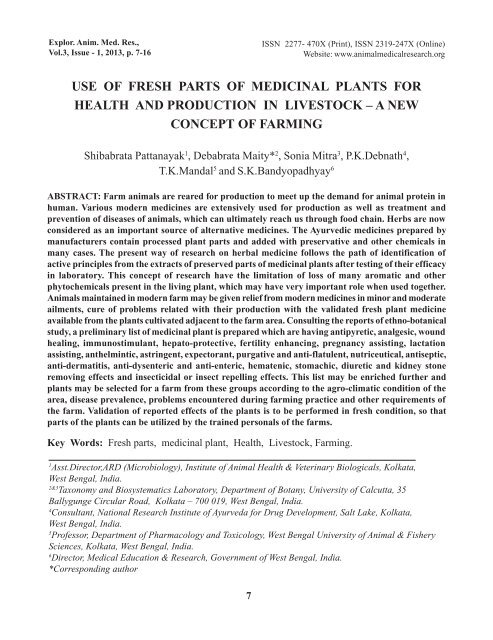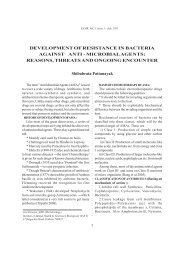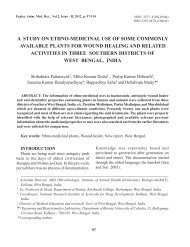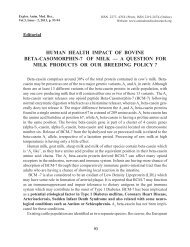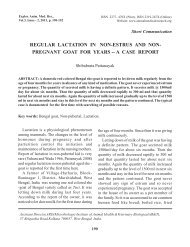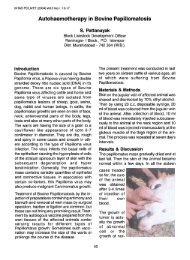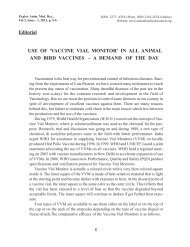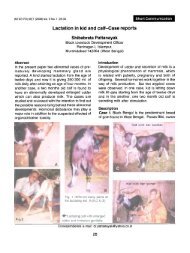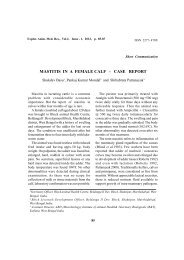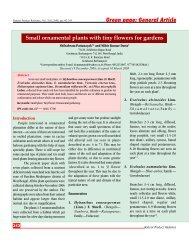p18feqgtqh1bhi1l3c16gu1g1713en4.pdf
Create successful ePaper yourself
Turn your PDF publications into a flip-book with our unique Google optimized e-Paper software.
Explor. Anim. Med. Res.,<br />
Vol.3, Issue - 1, 2013, p. 7-16<br />
ISSN 2277- 470X (Print), ISSN 2319-247X (Online)<br />
Website: www.animalmedicalresearch.org<br />
USE OF FRESH PARTS OF MEDICINAL PLANTS FOR<br />
HEALTH AND PRODUCTION IN LIVESTOCK – A NEW<br />
CONCEPT OF FARMING<br />
Shibabrata Pattanayak 1 , Debabrata Maity* 2 , Sonia Mitra 3 , P.K.Debnath 4 ,<br />
T.K.Mandal 5 and S.K.Bandyopadhyay 6<br />
ABSTRACT: Farm animals are reared for production to meet up the demand for animal protein in<br />
human. Various modern medicines are extensively used for production as well as treatment and<br />
prevention of diseases of animals, which can ultimately reach us through food chain. Herbs are now<br />
considered as an important source of alternative medicines. The Ayurvedic medicines prepared by<br />
manufacturers contain processed plant parts and added with preservative and other chemicals in<br />
many cases. The present way of research on herbal medicine follows the path of identification of<br />
active principles from the extracts of preserved parts of medicinal plants after testing of their efficacy<br />
in laboratory. This concept of research have the limitation of loss of many aromatic and other<br />
phytochemicals present in the living plant, which may have very important role when used together.<br />
Animals maintained in modern farm may be given relief from modern medicines in minor and moderate<br />
ailments, cure of problems related with their production with the validated fresh plant medicine<br />
available from the plants cultivated adjacent to the farm area. Consulting the reports of ethno-botanical<br />
study, a preliminary list of medicinal plant is prepared which are having antipyretic, analgesic, wound<br />
healing, immunostimulant, hepato-protective, fertility enhancing, pregnancy assisting, lactation<br />
assisting, anthelmintic, astringent, expectorant, purgative and anti-flatulent, nutriceutical, antiseptic,<br />
anti-dermatitis, anti-dysenteric and anti-enteric, hematenic, stomachic, diuretic and kidney stone<br />
removing effects and insecticidal or insect repelling effects. This list may be enriched further and<br />
plants may be selected for a farm from these groups according to the agro-climatic condition of the<br />
area, disease prevalence, problems encountered during farming practice and other requirements of<br />
the farm. Validation of reported effects of the plants is to be performed in fresh condition, so that<br />
parts of the plants can be utilized by the trained personals of the farms.<br />
Key Words: Fresh parts, medicinal plant, Health, Livestock, Farming.<br />
1<br />
Asst.Director,ARD (Microbiology), Institute of Animal Health & Veterinary Biologicals, Kolkata,<br />
West Bengal, India.<br />
2&3<br />
Taxonomy and Biosystematics Laboratory, Department of Botany, University of Calcutta, 35<br />
Ballygunge Circular Road, Kolkata – 700 019, West Bengal, India.<br />
4<br />
Consultant, National Research Institute of Ayurveda for Drug Development, Salt Lake, Kolkata,<br />
West Bengal, India.<br />
5<br />
Professor, Department of Pharmacology and Toxicology, West Bengal University of Animal & Fishery<br />
Sciences, Kolkata, West Bengal, India.<br />
6<br />
Director, Medical Education & Research, Government of West Bengal, India.<br />
*Corresponding author<br />
7
Exploratory Animal and Medical Research, Vol.3, Issue -1, June, 2013<br />
INTRODUCTION<br />
Present day farm animals are the successors<br />
of their free living ancestors. Domestication of<br />
animals was started thousands of years ago as<br />
documented in the signs of the ancient<br />
civilizations. As most of the modern farm<br />
animals are herbivorous, their body system is<br />
accustomed with utilization of nutrients<br />
available after digestion of plant materials.<br />
Concept of addition of animal protein, minerals,<br />
growth promoters, pre and probiotics etc. in the<br />
feeds of farm animals is need based with less<br />
expenditure through feeding, breeding and<br />
management. As a part of management, we<br />
developed health care systems of the farm<br />
animals with the tools available in our hand for<br />
our use. In many cases that was not properly<br />
effective due to the physiological / systemic<br />
differences among man and different species<br />
of animals, but we adhered with our concept.<br />
Sometimes we used the resources at libidum<br />
among farm animals. Apart from the issue of<br />
huge financial involvement, the dangers behind<br />
this concept are appearing in last few years. Mad<br />
cow disease, gathering of toxic chemicals in our<br />
body from animal, fish and bird products and<br />
expression of their effects through various<br />
diseases, increased incidence of several<br />
zoonotic diseases, development of resistance<br />
among micro-organisms against antibiotics,<br />
development of superbug etc. are examples.<br />
In this context, the idea of using plant derived<br />
medicines among the animals is a good concept.<br />
But the pharmaceutical companies producing<br />
various herbal medicines for animals are<br />
following the same concept of preparation of<br />
marketable medicines like that of modern<br />
allopathic medicines. Parts of the reported<br />
medicinal plants are stored, processed and<br />
mixed with chemical preservatives, coloring<br />
and palatable materials before marketing. In the<br />
way of collection, transportation, storage and<br />
processing of these plant parts, almost all the<br />
volatile and aromatic ingredients may be lost.<br />
Some of the temperature and humidity sensitive<br />
ingredients may also become ineffective due to<br />
these reasons.<br />
CONTEMPORARY METHODS OF<br />
STUDY<br />
Plants reported to have any medicinal effect<br />
are now identified by ethno-botanical study.<br />
After identification and characterization, the<br />
reported plant parts are collected and preserved.<br />
Then methanolic, ether, acetone or aqueous<br />
extract of the preserved plant part is stored.<br />
Then these are tested for their reported<br />
medicinal use in vitro or among in vivo animal<br />
models, either in this form or in semi-purified<br />
or purified form after extraction of active<br />
principles. The efficacy of the extracted part or<br />
the separated active principles cannot show the<br />
total effect of the plant part in question, as many<br />
of the principles become lost during the whole<br />
process.<br />
PROPOSAL FOR FARMING WITH<br />
NEW CONCEPT<br />
To overcome the problems of partial study<br />
of effectiveness and to utilize (and also to<br />
validate when needed) the medicinal effect of<br />
reported plants the animal farms, a new concept<br />
may be designed.<br />
a) Every animal farm may be added with a<br />
small medicinal plant garden of selected plants<br />
for supply of fresh inputs.<br />
b) These can be used for better production<br />
and prevention and treatment of minor and<br />
moderate ailments.<br />
c) Trained personals may be used for mixing<br />
8
Use of fresh parts of medicinal plants for health and production in livestock...<br />
of parts of plants and their use.<br />
d) Study for proper validation of the<br />
medicinal effect of known, common use as well<br />
as non-familiar use of plants may be done.<br />
e) Study on effectiveness and side effects of<br />
combined use of parts of plants may be done.<br />
f) Parts of the plants grown at different agroclimatic<br />
condition may be mixed as a part of<br />
mixture, if required.<br />
g) Standardization of dose schedule are also<br />
to be determined for that purpose.<br />
h) Beside supplying parts for medicinal use,<br />
many of these plants may supply green fodder<br />
to the animal.<br />
PLANTS WHICH MAY BE USED<br />
IN ANIMAL HUSBANDRY<br />
According to available literature, several<br />
plants are reported to have medicinal properties<br />
on diseases of human and animals. Similar<br />
effects on same type of diseases/ailments of<br />
both human and animals are observed. These<br />
reports may be gathered to prepare a knowledge<br />
base for further study. Like modern medicines,<br />
research for validation of such claims may be<br />
started on animals. As herbivorous animals took<br />
herbs as their normal diet, they may be given<br />
such oral medicinal herbs after a trial on<br />
laboratory animals, particularly to know the<br />
possible toxic effects of the medicinal plants.<br />
Study of medicinal effects by local application<br />
of plant parts may be started on laboratory<br />
animals as well as on farm animals in a limited<br />
scale primarily. Wide spread use of effective<br />
plants may be started afterwards.<br />
Plants having possible effects on prevention<br />
and cure of common health and production<br />
related problems are listed in twenty groups.<br />
This primary list contains the names of some<br />
representative plants available mainly in plains<br />
of our country which may be modified with<br />
gathering of more information.<br />
Plants with antipyretic effect:<br />
Nyctanthes arbor-tristis L., Hemidesmus<br />
indicus (L.) R. Br. ex Schult (Jain 1995),<br />
Tylophora indica (Burm. f.) Merr., Coscinium<br />
fenestratum (Goetgh.) Colebr (Jain 1995),<br />
Aristolochia indica L. (Jain 1995), Stephania<br />
japonica (Thunb.) Miers, Solanum virginianum<br />
L., Solanum americanum Mill., Centella<br />
asiatica (L.) Urb., Rauwolfia serpentina Baill.<br />
(Jain 1995), Tinospora cordifolia (Willd.) Miers<br />
(Jain 1995, Biswas et al. 2009), Andrographis<br />
paniculata (Burm.f.) Nees (Jain 1995), Swertia<br />
chirata Buch.-Ham. ex Wall. (Jain 1995), Aloe<br />
vera (L.) Burm.f., Sida cordifolia L. (Jain<br />
1995), Peganum harmala L. (Jain 1995),<br />
Capparis zeylanica L. (Lather et al. 2010),<br />
Terminalia arjuna (Roxb. ex DC.) Wight &<br />
Arn., Leucas aspera (Willd.) Link<br />
(Sunilchandra et al. 2008) etc.<br />
Plants with Analgesic effect:<br />
Cassia fistula L., Curcuma longa L.,<br />
Aristolochia indica L., Butea monosperma<br />
(Lam.) Taub., Dillenia indica L., Mikania<br />
scandens (L.) Willd., Ficus racemosa L.,<br />
Commiphora mukul (Hook. ex Stocks) Engl.,<br />
Vitex negundo L., Ricinus communis L., Vanda<br />
tessellata (Roxb.) Hook. ex G.Don, Piper<br />
longum L. (Jain 1995), Tinospora cordifolia<br />
(Willd.) Miers, Zingiber officinale Roscoe,<br />
Moringa oleifera Lam., Argyreia nervosa<br />
(Burm. f.) Bojer, Clitoria ternatea L. (Biswas<br />
et al. 2009), Azadirachta indica A.Juss.,<br />
Peganum harmala L. (Jain 1995), Pergularia<br />
daemia (Forssk.) Chiov. (Jain 1995), Saussurea<br />
costus (Falc.) Lipsch. (Jain 1995)., Capparis<br />
zeylanica L. (Lather et al. 2010). Antidesma<br />
9
Exploratory Animal and Medical Research, Vol.3, Issue -1, June, 2013<br />
montanum var. montanum , Acacia senegal (L.)<br />
Willd., Glycyrrhiza glabra L., Rotheca serrata<br />
(L.) Steane & Mabb. (Sunilchandra et al.2008)<br />
etc.<br />
Plants with wound healing effect :<br />
Barleria lupulina Lindl., Blumea lacera<br />
(Burm.f.) DC., Vigna unguiculata subsp.<br />
unguiculata (L.) Walp., Adhatoda vasica Nees,<br />
Cynodon dactylon (L.) Pers. .(Annon 1950).,<br />
Curcuma longa L., Glinus lotoides L.,<br />
Eupatorium triplinerve Vahl, (Annon 1952).,<br />
Aloe vera (L.) Burm.f. (Biswas et al.2009),,<br />
Mikania scandens (L.) Willd., Artemisia<br />
nilagirica (C.B.Clarke) Pamp. (Pattanayak et<br />
al. 2012), Croton bonplandianum Baill. (Pal<br />
and Jain 1998), Dillenia indica L., Diospyros<br />
malabarica (Desr.) Kostel., Eclipta prostrata<br />
(L.) L., Tagetes patula L., Pandanus foetidus<br />
Roxb. (Pattanayak et al. 2012),<br />
Achyranthes aspera L. (Chopra and Nayer<br />
1956) Anisomeles indica (Baranwal et al. 2012,<br />
Pattanayak et al. 2012), Aristolochia indica L.<br />
(Jain 1995), Bambusa bambos (L.) Voss<br />
(Pattanayak et al. 2012), Bryophyllum pinnatum<br />
(Lam.) Oken (Ambasta 1986), Capparis<br />
zeylanica L. (Lather et al. 2010, Pattanayak<br />
et al. 2012), Senna sophera (L.) Roxb. (Chopra<br />
and Nayer 1956), Coccinia grandis (L.) Voigt<br />
(Pattanayak et al. 2012), Heliotropium indicum<br />
L. (Annon 1959), Litsea glutinosa (Lour.) C.B.<br />
Rob. (Ambasta 1986, Pattanayak et al. 2012),<br />
Solanum virginianum L. (Jain 1995).<br />
Helianthus annuus L. (Roychowdhury 2008),<br />
Garcinia morella (Gaertn.) Desr.<br />
(Roychowdhury 2008), Jasminum auriculatum<br />
Vahl, (Roychowdhury 2008), Cyanthillium<br />
cinereum (L.) H.Rob. (Roychowdhury 2008),<br />
Sida cordifolia L., Terminalia chebula Retz.<br />
(Jain 1995), Withania somnifera (L.) Dunal<br />
(Jain 1995), Senna alata (L.) Roxb.<br />
(Sunilchandra et al. 2008) etc.<br />
Plants with immunostimulant effect:<br />
Tinosporas cordifolia (Willd.) Miers,<br />
(Roychowdhury 2008, Biswas et al. 2009)<br />
Andrographis paniculata (Burm.f.) Nees,<br />
Centella asiatica (L.) Urb., Withania somnifera<br />
(L.) Dunal, Phyllanthus emblica L., Asparagus<br />
racemosus Willd., Boerhavia diffusa L.<br />
(Roychowdhur 2008), Ocimum tenuiflorum L.<br />
(Sunilchandra et al. 2008), Curcuma longa L.<br />
(Roychowdhury 2008), Azadirachta indica<br />
A.Juss. (Roychowdhury 2008), Zingiber<br />
officinale Roscoe (Roychowdhury 2008),<br />
Hygrophila auriculata (Schumach.) Heine (Jain<br />
1995), Capparis zeylanica L. (Lather et al.<br />
2010) etc.<br />
Plants with Hepato-protective property:<br />
Andrographis paniculata (Burm.f.) Nees (Jain<br />
1995), Phyllanthus niruri L. (Roychowdhury<br />
2008), Pterocarpus marsupium Roxb.,<br />
(Roychowdhury 2008)., Solanum americanum<br />
Mill., Azadirachta indica A.Juss. , Centella<br />
asiatica (L.) Urb., Ocimum tenuiflorum L.,<br />
Phyllanthus emblica L. (Jain 1995).,<br />
Phyllanthus amarus Schumach. & Thonn.,<br />
Tinospora cordifolia (Willd.) Miers, Boerhavia<br />
diffusa L. (Jain 1995), Phyllanthus fraternus<br />
G.L.Webster, Ricinus communis L., Swertia<br />
chirata Buch.-Ham. ex Wall. (Jain 1995),<br />
Peganum harmala L. (Jain 1995), Adhatoda<br />
vasica Nees, Wedelia chinensis (Osbeck) Merr.<br />
(Biswas et al. 2009), Curcuma longa L.,<br />
Gardenia resinifera Roth, Emblica officinalis<br />
Gaertn., Woodfordia fruticosa (L.) Kurz<br />
(Sunilchandra et al. 2008) etc.<br />
10
Use of fresh parts of medicinal plants for health and production in livestock ...<br />
Plants with effect on fertility and libido:<br />
Withania somnifera (L.) Dunal (Jain 1995).,<br />
Tribulus terrestris L.(Jain 1995), Aloe vera (L.)<br />
Burm.f., Saraca indica L. (Biswas et al. 2009),<br />
Asparagus racemosus Willd., Bacopa<br />
monnieri (L.) Wettst., Sida cordifolia L.<br />
(Jain,1995), Mucuna pruriens (L.)<br />
DC.(Roychowdhury 2008), Ipomoea<br />
mauritiana Jacq. (Roychowdhury 2008),<br />
Cheilocostus speciosus (J.König) C.Specht<br />
(Roychowdhury, 2008), Piper betle L.<br />
(Roychowdhury 2008), Tinospora cordifolia<br />
(Willd.) Miers (Jain 1995). Cinnamomum<br />
verum J.Presl, Azadirachta indica A.Juss.<br />
(Sunilchandra et al. 2008) etc.<br />
Plants with effect on pregnancy and<br />
parturition:<br />
Ficus religiosa L., Nelumbo nucifera Gaertn.,<br />
Hibiscus rosa-sinensis L., Pergularia daemia<br />
(Forssk.) Chiov. (Jain 1995)., Asparagus<br />
racemosus Willd., Tectona grandis L.f.,<br />
Woodfordia fruticosa (L.) Kurz, Mimosa pudica<br />
L., Cucurbita pepo L. (Sunilchandra et al. 2008)<br />
Rauwolfia serpentina Baill., Abrus precatorius<br />
L., Mesua ferrea L., Saraca asoca (Roxb.)<br />
Willd. (Jain 1995) etc.<br />
Plants with effect on lactation:<br />
Acacia nilotica (L.) Delile, Ipomoea<br />
mauritiana Jacq., Ipomoea aquatica Forssk.,<br />
Euphorbia hirta L. (Jain 1995), Asparagus<br />
racemosus Willd. Mimosa pudica L. (Sunil<br />
chandra et al. 2008), Madhuca longifolia<br />
(J.König ex L.) J.F.Macbr. (Jain 1995).,<br />
Leptadenia reticulata (Retz.) Wight & Arn.,<br />
Ambroma augusta (L.) L.f. (Roychowdhury<br />
2008), Cuminum cyminum L. (Roychowdhury<br />
2008), Nigella sativa L. (Roychowdhury 2008),<br />
Ficus hispida L.f. (Sunilchandra et al. 2008)<br />
Abrus precatorius L. (Roychowdhury 2008),<br />
Tinospora cordifolia (Willd.) Miers<br />
(Roychowdhury 2008), Zingiber officinale<br />
Roscoe (Roychowdhury 2008) etc.<br />
Plants with Anthelmintic property :<br />
Vernonia anthelmintica (L.) Willd. (Jain 1995),<br />
Embelia ribes Burm.f., Mallotus philippensis<br />
(Lam.) Müll.Arg. (Jain 1995), Butea<br />
monosperma (Lam.) Taub. (Jain 1995, Biswas<br />
et al. 2009) Andrographis paniculata (Burm.f.)<br />
Nees (Jain 1995), Holarrhena pubescens Wall.,<br />
Punica granatum L., Acorus calamus L.,<br />
Swertia chirata Buch.-Ham. ex Wall. (Jain<br />
1995), Artemisia nilagirica (C.B.Clarke) Pamp.<br />
(Jain 1995), Adhatoda vasica Nees, Azadirachta<br />
indica A.Juss., Curcuma longa L., Areca<br />
catechu L. (Jain 1995), Ficus racemosa L.,<br />
Nyctanthes arbor-tristis L., Euphorbia hirta L.<br />
(Jain 1995), Peganum harmala L. (Jain 1995),<br />
Cullen corylifolium (L.) Medik. (Jain 1995).<br />
Cucurbita pepo L. (Sunilchandra et al. 2008),<br />
Albizia lebbeck (L.) Benth. (Biswas et al. 2009)<br />
etc.<br />
Plants with astringent property:<br />
Andrographis paniculata (Burm.f.) Nees,<br />
Azadirachta indica A.Juss., Aegle marmelos<br />
(L.) Corrêa (Jain 1995), Cyperus rotundus L.<br />
(Roychowdhury 2008), Terminalia chebula<br />
Retz. (Roychowdhury 2008), Piper nigrum L.<br />
(Roychowdhury 2008), Eclipta prostrata (L.)<br />
L. (Roychoudhury 2008), Symplocos racemosa<br />
Roxb.(Jain 1995), Saraca indica L., Terminalia<br />
arjuna (Roxb. ex DC.) Wight & Arn., Prunus<br />
serotina Ehrh., Acacia catechu (L.f.) Willd.,<br />
Gardenia resinifera Roth (Sunilchandra et al.<br />
2008), Plectranthus amboinicus (Lour.)<br />
Spreng. (Biswas et al. 2009) etc.<br />
11
Exploratory Animal and Medical Research, Vol.3, Issue -1, June, 2013<br />
Plants with expectorant and antibronchitis<br />
property:<br />
Adhatoda vasica Nees (Jain 1995), Solanum<br />
virginianum L., Solanum americanum Mill.<br />
(Jain 1995), Glycyrrhiza glabra L. (Jain 1995),<br />
Albizia lebbeck (L.) Benth. (Roychowdhury<br />
2008), Datura fastuosa L. (Biswas et al. 2009),<br />
Ocimum tenuiflorum L. (Jain 1995),<br />
(Roychowdhury 2008), Phyllanthus emblica L.,<br />
Piper longum L. (Jain 1995, Biswas et al. 2009),<br />
Pergularia daemia (Forssk.) Chiov. (Jain 1995),<br />
Andrographis paniculata (Burm.f.) Nees,<br />
Catharanthus roseus (L.) G.Don, Centella<br />
asiatica (L.) Urb., Curcuma longa L., Abrus<br />
precatorius L., Holarrhena pubescens Wall.,<br />
Euphorbia hirta L. (Jain 1995), Peganum<br />
harmala L. (Jain 1995), Acalypha indica L.,<br />
Ephedra gerardiana Wall. ex Stapf, Hygrophila<br />
auriculata (Schumach.) Heine, Madhuca<br />
longifolia (J.König ex L.) J.F.Macbr. (Jain<br />
1995), Saussurea costus (Falc.) Lipsch. (Jain<br />
1995), Syzygium cumini (L.) Skeels (Jain 1995),<br />
Zingiber officinale Roscoe (Biswas et al. 2009)<br />
Tylophora indica (Burm. f.) Merr., Drimia<br />
maritima (L.) Stearn, Terminalia chebula Retz.,<br />
Prunus serotina Ehrh., Eucalyptus globulus<br />
Labill., Myroxylon balsamum (L.) Harms,<br />
Emblica officinalis Gaertn., Plectranthus<br />
amboinicus (Lour.) Spreng.(Sunilchandra et al.<br />
2008) etc.<br />
Plants with purgative and anti-flatulent<br />
property:<br />
Senna alexandrina Mill., Cassia fistula L.<br />
(Jain 1995), Mentha arvensis L. Abrus<br />
precatorius L. (Jain 1995),, Piper longum L.<br />
(Jain 1995, Sunilchandra et al. 2008), Ricinus<br />
communis L., Operculina turpethum (L.) Silva<br />
Manso (Biswas et al. 2009), Aegle marmelos<br />
(L.) Corrêa., Andrographis paniculata<br />
(Burm.f.) Nees, Cheilocostus speciosus<br />
(J.König) C.Specht (Jain 1995), Terminalia<br />
chebula Retz., Terminalia belerica Roxb.<br />
(Biswas et al. 2009), Plantago orbignyana<br />
Steinh. ex Decne. Cinnamomum verum J.Presl,<br />
Elettaria cardamomum (L.) Maton, Kavalama<br />
urens (Roxb.) Raf., Coriandrum sativum L.,<br />
Anethum sowa Roxb. ex Fleming, Nardostachys<br />
jatamansi (D. Don) DC., Myristica fragrans<br />
Houtt., Ocimum tenuiflorum L., Pinus palustris<br />
Mill., Ferula foetida (Bunge) Regel, Capsicum<br />
annuum L., Zingiber officinale Roscoe, Aloe<br />
vera (L.) Burm.f., Glycyrrhiza glabra L.,<br />
Emblica officinalis Gaertn., Sida cordifolia L.,<br />
Putranjiva roxburghii Wall., Cuminum<br />
cyminum L., Plectranthus amboinicus (Lour.)<br />
Spreng., Ficus hispida L.f. (Sunilchandra et al.<br />
2008).<br />
Plants with nutriceutical Property:<br />
Ipomoea aquatica Forssk., Phyllanthus<br />
emblica L., Curcuma longa L., Phyllanthus<br />
emblica L. (Jain 1995), Piper longum L. (Jain<br />
1995), Daucus carota L., (www.<br />
healthfromnature.net ), Triticum aestivum L.<br />
(Sunilchandra et al. 2008) etc.<br />
Plants with antiseptic property:<br />
Andrographis paniculata (Burm.f.) Nees<br />
(Jain 1995), Aloe vera (L.) Burm.f., Azadirachta<br />
indica A.Juss., Madhuca longifolia (J.König ex<br />
L.) J.F.Macbr., Mentha arvensis L. (Jain 1995),<br />
Hydnocarpus kurzii (King) Warb. (Jain 1995),<br />
Coscinium fenestratum (Goetgh.) Colebr.,<br />
Hemidesmus indicus (L.) R. Br. ex Schult. (Jain<br />
1995), Ficus religiosa L., Cassia fistula L.,<br />
Schleichera oleosa (Lour.) Merr., Glycyrrhiza<br />
glabra L. (Jain 1995), Catharanthus roseus (L.)<br />
12
Use of fresh parts of medicinal plants for health and production in livestock ...<br />
G.Don, Centella asiatica (L.) Urb., Curcuma<br />
longa L., Ocimum tenuiflorum L. (Jain 1995),<br />
Eclipta prostrata (L.) L., Aegle marmelos (L.)<br />
Corrêa (Jain 1995), Cassia fistula L., Lawsonia<br />
inermis L., Withania somnifera (L.) Dunal,<br />
Solanum virginianum L. (Jain 1995), Piper<br />
longum L., (Jain 1995, Sunilchandra et al.<br />
2008), Peganum harmala L. (Jain 1995), Cullen<br />
corylifolium (L.) Medik. (Jain 1995), Saussurea<br />
costus (Falc.) Lipsch. (Jain 1995), Allium<br />
sativum L., Cymbopogon flexuosus (Nees ex<br />
Steud.) W.Watson, Gardenia resinifera Roth,<br />
Emblica officinalis Gaertn., Senna alata (L.)<br />
Roxb., Woodfordia fruticosa (L.) Kurz,<br />
Asparagus racemosus Willd., Cuminum<br />
cyminum L., Plectranthus amboinicus (Lour.)<br />
Spreng. (Sunilchandra et al. 2008) etc.<br />
Plants with anti-dermatitis and skin<br />
disease curing effect:<br />
Hemidesmus indicus (L.) R. Br. ex Schult<br />
(Jain 1995), Andrographis paniculata (Burm.f.)<br />
Nees (Jain 1995), Azadirachta indica A.Juss.<br />
(Jain 1995), Curcuma longa L., Phyllanthus<br />
amarus Schumach. & Thonn., Coccinia grandis<br />
(L.) Voigt, Stevia rebaudiana (Bertoni) Bertoni,<br />
Withania somnifera (L.) Dunal, Butea<br />
monosperma (Lam.) Taub. (Jain 1995, Biswas<br />
et al. 2009), Datura metel L., Ocimum<br />
tenuiflorum L. (Jain 1995), Dillenia indica L.,<br />
Eclipta prostrata (L.) L., Ficus racemosa L.,<br />
Embelia ribes Burm.f., Acacia nilotica (L.)<br />
Delile, Adhatoda vasica Nees, Sida cordifolia<br />
L., Senna sophera (L.) Roxb., Madhuca<br />
longifolia (J.König ex L.) J.F.Macbr. (Jain<br />
1995), Cullen corylifolium (L.) Medik.,<br />
Pterocarpus marsupium Roxb.(Jain 1995),<br />
Saussurea costus (Falc.) Lipsch.(Jain 1995),<br />
Solanum americanum Mill., Symplocos<br />
racemosa Roxb. (Jain 1995), Syzygium cumini<br />
(L.) Skeels (Jain 1995), Antidesma montanum<br />
var. montanum , Aloe vera (L.) Burm.f., Drimia<br />
maritima (L.) Stearn, Saraca indica L., Mentha<br />
arvensis L., Senna alata (L.) Roxb., Tectona<br />
grandis L.f., Leucas aspera (Willd.) Link,<br />
Plectranthus amboinicus (Lour.) Spreng., Aegle<br />
marmelos (L.) Corrêa (Sunilchandra et al.<br />
2008), Vitex negundo L., Wedelia chinensis<br />
(Osbeck) Merr. (Biswas et al. 2009) etc.<br />
Plants with anti-dysentery and anti<br />
enteritic property:<br />
Holarrhina pubescens Wall.ex DC.(Jain<br />
1995), Cyperus rotundus L., Acorus calamus<br />
L., Centella asiatica (L.) Urb., Tylophora indica<br />
(Burm. f.) Merr. (Jain 1995), Strychnos nuxvomica<br />
L., Achyranthes aspera L.,<br />
Andrographis paniculata (Burm.f.) Nees (Jain<br />
1995), Phyllanthus amarus Schumach. &<br />
Thonn., Hemidesmus indicus (L.) R. Br. ex<br />
Schult, Paederia foetida L., Rauwolfia<br />
serpentina Baill. (Jain 1995), Aegle marmelos<br />
(L.) Corrêa (Jain 1995), Asparagus racemosus<br />
Willd., Pergularia daemia (Forssk.) Chiov.<br />
(Jain 1995)., Embelia ribes Burm.f., Punica<br />
granatum L., Acacia nilotica (L.) Delile, Ficus<br />
racemosa L., Mimosa pudica L., Phyllanthus<br />
emblica L., Plantago orbignyana Steinh. ex<br />
Decne. (Jain 1995), Carapichea ipecacuanha<br />
(Brot.) L.Andersson, Pterocarpus marsupium<br />
Roxb. (Jain 1995), Saraca asoca (Roxb.) Willd.<br />
(Jain 1995), Solanum americanum Mill. (Jain<br />
1995), Syzygium cumini (L.) Skeels (Jain 1995),<br />
Tinospora cordifolia (Willd.) Miers (Jain 1995)<br />
etc.<br />
13
Exploratory Animal and Medical Research, Vol.3, Issue -1, June, 2013<br />
Hematenic and blood parameters<br />
influencing Plant:<br />
Hygrophila auriculata (Schumach.) Heine<br />
(Gomes et el. 2001), Salacia chinensis L.<br />
(Sikanwar and Patil 2012), Aristolochia indica<br />
L. (http//siddham.in/topic/blood purifier 2010),<br />
Triticum aestivum L., Spinacia oleracea L.,<br />
Beta vulgaris L. (Bond 2011) etc.<br />
Diuretic and Kidney stone removing<br />
plant:<br />
Plectranthus amboinicus (Lour.) Spreng.<br />
(Biswas et al. 2009), Vigna unguiculata subsp.<br />
unguiculata (L.) Walp., Boerhavia diffusa Lin.,<br />
Bryophyllum pinnatum (Lam.) Oken, Solanum<br />
virginianum L., Phyllanthus amarus Schumach.<br />
& Thonn., Peganum harmala L. (Jain 1995),<br />
Tribulus terrestris L. (Sunilchandra et al. 2008,<br />
Biswas et al. 2009), Antidesma montanum var.<br />
montanum, Glycyrrhiza glabra L., Anethum<br />
sowa Roxb. ex Fleming, Putranjiva roxburghii<br />
Wall. (Sunilchandra et al. 2008) etc.<br />
Plants having insect repellent or<br />
insecticidal property:<br />
Cymbopogon flexuosus (Nees ex Steud.)<br />
W.Watson, Ocimum tenuiflorum L., Pinus<br />
palustris Mill., Azadirachta indica A.Juss.,<br />
Leucas aspera (Willd.) Link, Jatropha curcas<br />
L. (Sunilchandra et al. 2008) etc.<br />
Plants with stomachic effect:<br />
Carapichea ipecacuanha (Brot.)<br />
L.Andersson, Cinnamomum verum J.Presl,<br />
Hemidesmus indicus (L.) R. Br. ex Schult (Jain<br />
1995), Allium sativum L., Nardostachys<br />
jatamansi (D. Don) DC., Cymbopogon<br />
flexuosus (Nees ex Steud.) W.Watson<br />
(Sunilchandra et al. 2008). Pipe0r longum L.<br />
(Jain 1995, Biswas et al. 2009), Piper nigrum<br />
L. (Biswas et al. 2009) Solanum americanum<br />
Mill. (Jain 1995), Swertia chirata Buch.-Ham.<br />
ex Wall., Symplocos racemosa Roxb. (Jain<br />
1995), Plectranthus amboinicus (Lour.)<br />
Spreng., Plumbago zeylanica L. (Biswas et al.<br />
2009) etc.<br />
SELECTION OF MEDICINAL<br />
PLANT:<br />
Plants may be selected for cultivation in a<br />
farm depending on following criteria :<br />
i) Selection of plant species will be according<br />
to the agro-climatic condition of the area.<br />
ii) It will be of minimum number.<br />
iii) It is seen that some plants grow as weeds<br />
and some others as naturally growing plants of<br />
an area. Selection of such plants will be given<br />
preference over exotic plants.<br />
iv) As different parts of a plant can be used<br />
for different purposes, singly or in combination<br />
with parts of other plants, availability of such<br />
member plants may be performed with planned<br />
plantation.<br />
v) It will be according to the species of animal<br />
of the farm, their common ailments in that<br />
particular area and their requirements.<br />
vi) In some cases, a few plant parts may have<br />
to be stored for other seasons than season of<br />
cultivation and in some cases some plant parts<br />
are to be purchased from outside due to<br />
requirement of completely separate agroclimatic<br />
condition for their cultivation.<br />
vii) Requirement of cultivation of exotic<br />
plant may be unavoidable in some cases. Effort<br />
will be given in arrangement of natural<br />
cultivation environment for such plants.<br />
viii) Use of inorganic fertilizer, chemical<br />
insecticide etc. may be avoided.<br />
14
Use of fresh parts of medicinal plants for health and production in livestock ...<br />
CONCLUSION<br />
Modern allopathic medicines are extensively<br />
used in the animal farming which are becoming<br />
sources of many serious problems. The plant<br />
derived medicines marketed by different<br />
pharmaceuticals for this purpose are not always<br />
effective in animals, might be due to loss of<br />
many active principles during processing and<br />
storage. To overcome this, every animal farm<br />
may be added with a small medicinal plant<br />
garden of selected plants for supply of fresh<br />
inputs for better production and prevention and<br />
treatment of minor and moderate ailments.<br />
Trained personals may be used for mixing of<br />
parts of plants and their use. Study for proper<br />
validation of the medicinal effect of known,<br />
common use as well as non familiar use of<br />
plants along with standardization of dose<br />
schedule will be determined for that purpose.<br />
ACKNOWLEDGEMENT<br />
Authors are thankful to the Hon'ble Vice-<br />
Chancellor, The West Bengal University of<br />
Health Sciences, for providing necessary<br />
facilities for studies related with this article.<br />
REFERENCES<br />
Ambasta SP(ed.).(1986). The Useful Plants of<br />
India. NISCAIR. CSIR. New Delhi.<br />
Annon. (1950). The Wealth of India, a dictionary<br />
of Indian raw materials an industrial products. Vol.2.<br />
CSIR. New Delhi. p.98 & 420-421.<br />
Annon. (1952). The Wealth of India, a dictionary<br />
of Indian raw materials an industrial products. Vol.3.<br />
CSIR. New Delhi. p.128 & 223.<br />
Annon.(1962). The Wealth of India, a dictionary<br />
of Indian raw materials an industrial products. Vol.6.<br />
CSIR. New Delhi. p.153-154 & 376.<br />
Baranwal VK, Irchhaya R and Singh S.(2012).<br />
Anisomeles indica : An overview. Int. Res. J. Pharm.<br />
3(1): 84-87.<br />
Biswas TK, Mitra A, Hazra A, Paul S and<br />
Debnath PK.(2009). Medicinal plants used in<br />
Ayurveda. National Medicinal Plants Board. Govt.<br />
of India. p.3-63.<br />
Bond O.(2011).Medicinal herbs for blood<br />
building. http://www.livestrong.com/article/364777-<br />
medicinal-herbs-for-blood building. Accessed on<br />
21.01.2013.<br />
Chopra RN and Nayer SL.(1956). Glossary of<br />
Indian Medicinal Plants. Vol.1. CSIR. New Delhi.<br />
Das S, Dave V, Bala A and Halder PK.(2012).<br />
Ethnomedicine as a source of antimicrobial agents:<br />
a comparative anti microbial study of different plants.<br />
Abstract no.SNPSJU0160, 12 th International<br />
Congress of Ethnopharmacology School of Natural<br />
Product Studies, Jadavpur University. India. p.129.<br />
Gomes A, Das M and Dasgupta SC.(2001).<br />
Hematenic effect of Hygrophila spinosa T Anderson<br />
on experimental rodents. Ind. J. Exp. Biol. 39(4):<br />
381-382.<br />
Roychowdhury R.(2008).The healing powers of<br />
herbs. Pantaloons Retail India Ltd. Mumbai –<br />
400060. p.28,32,54,62.<br />
Jain SK.(1995). Medicinal plants. National Book<br />
Trust. .New Delhi. India. p.9-175.<br />
Lather A, Chaudhury AK, Gupta V, Bansal P<br />
and Bansal R.(2010). Phytochemistry and<br />
pharmacological activities of Capparis zeylanica : An<br />
overview. Int. I. Res. Ayur. Pharm. 1(2): 383-389.<br />
Mukhopadhyay S, Pal D.C and Debnath<br />
P.K.(1999). Banglar Osodhi Gachh (Medicinal<br />
Plants of Bengal, Bengali). Paschim Banga Bighan<br />
Mancha. p.12-40.<br />
15
Exploratory Animal and Medical Research, Vol.3, Issue -1, June, 2013<br />
Medicinal plants of India. ( http://bsienvis.org/<br />
medi.htm) accessed on 28.02.2008. p.2-62.<br />
Sikanwar MS and Patil MB.(2012).<br />
Antihyperlipidemic activities of Salacia chenesis root<br />
extracts in triton induced and atherogenic diet<br />
induced hyperlipidemic rats. Ind. J. Pharm. 44(1) :<br />
88-92.<br />
Pal DC and Jain SK.(1998). Tribal Medicine.<br />
Naya Prokash. Kolkata. p.49-242.<br />
Pattanayak S, Dutta MK, Debnath PK,<br />
Bandyopadhyay SK, Saha B and Maity D.(2012).<br />
A study on ethno-medicinal use of some commonly<br />
available plants for wound healing and related<br />
activities in three southern districts of West Bengal,<br />
India. Explor. Anim. Med. Res . 2(2) : 97-110.<br />
Sunilchandra U, Vijaykumar M and Sravanthi<br />
P.(2008). Phytomedicines in Veterinary practice.<br />
North East Vet. 8(2) : 4-7.<br />
www.healthfromnature.net.(2011). accessed on<br />
11.12.2012. Article: Carrot (Daucus carota).<br />
http://siddham.in/topic/blood purifier.(2010).<br />
Accesed on 11.12.2012.<br />
16


